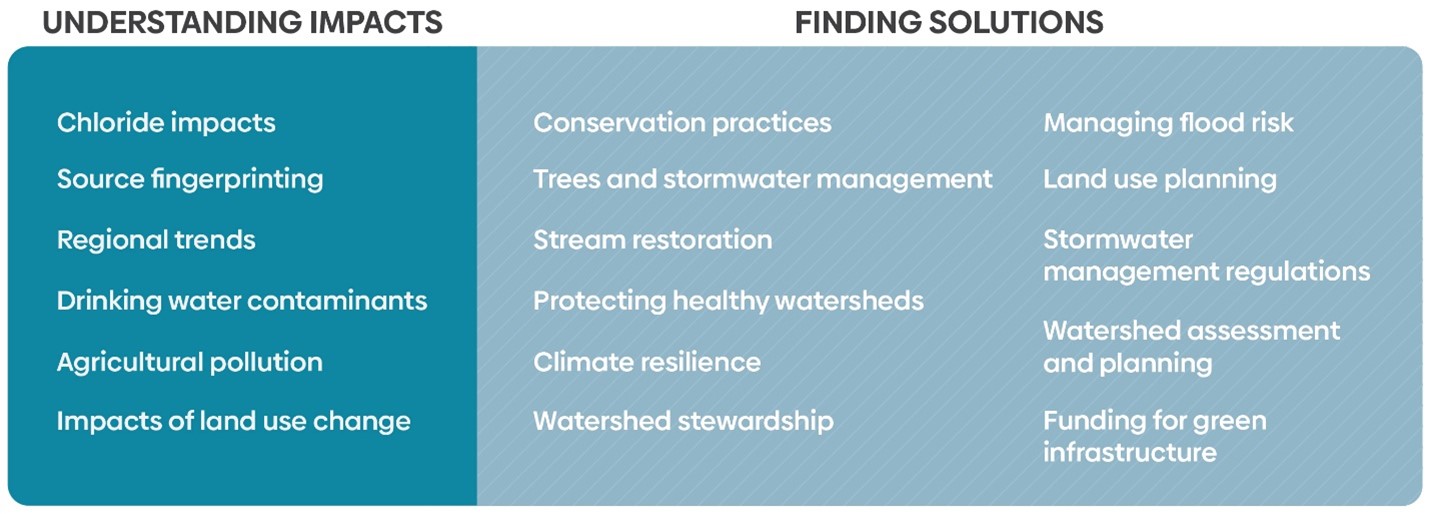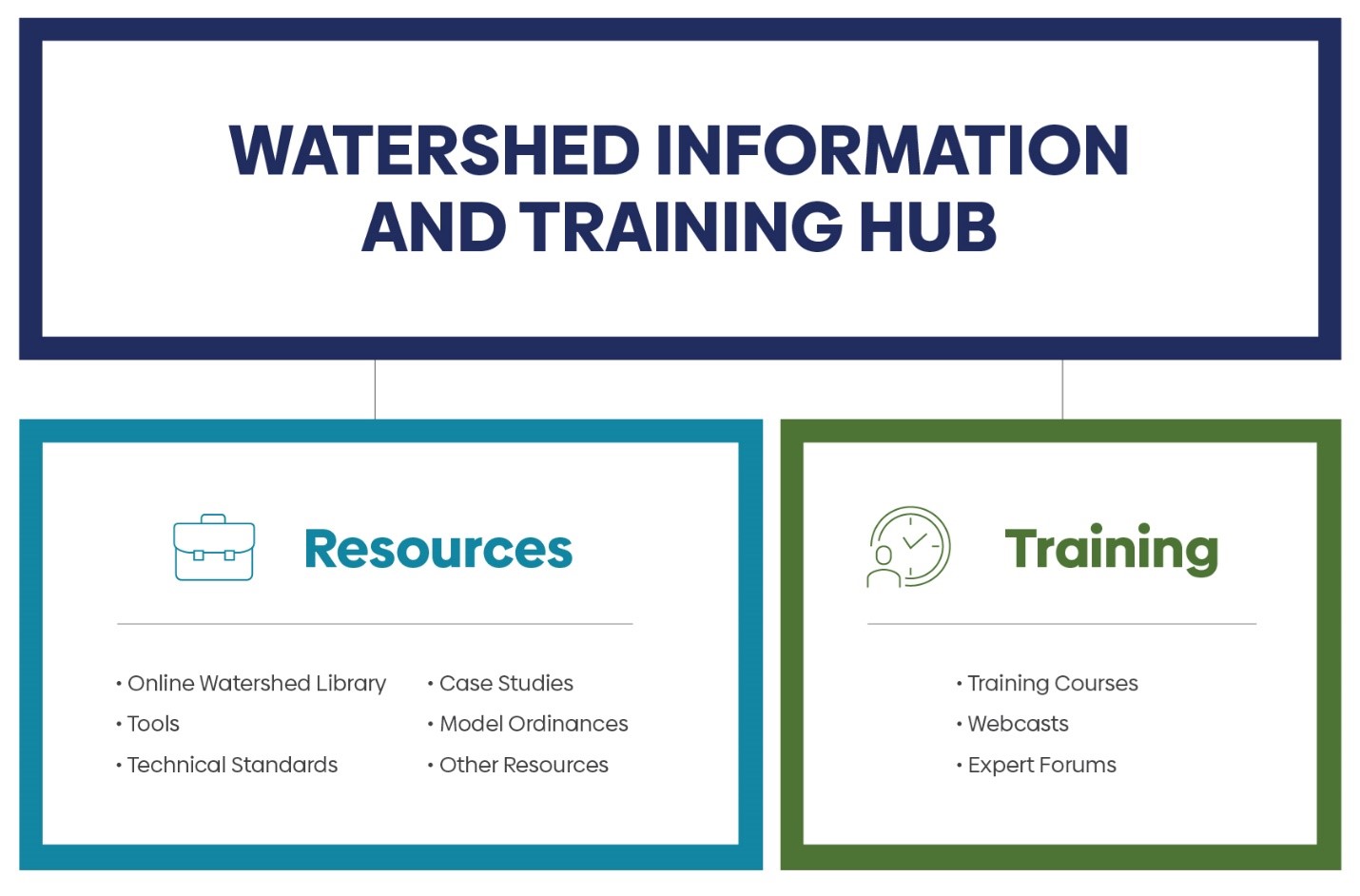National Watershed Research Network
Connecting communities with the resources, tools, and training to meet clean water goals
Communities across the country are working hard to meet clean water goals. Municipalities, nonprofits, and other organizations need answers to a growing set of research questions about the causes of watershed impacts and effective solutions to address them. Lack of information, funding, time, and staff resources often contribute to delayed or no progress on advancing the translation of research to measurable action within these communities.
That’s where the National Watershed Research Network comes in.
This collaborative helps communities achieve clean water and healthy watersheds by funding applied research on topics determined by its members. Together, we aim to provide insights into the impacts of land use activities on water resources, and identify regulations, programs, and practices that can best prevent or mitigate these impacts and address community needs.
National Watershed Research Network Goals:
National Watershed Research Network Structure Overview
The Network’s Steering Committee provides oversight, sets priorities, and helps to leverage funding and partnerships. The Center for Watershed Protection is the Network lead and is nationally recognized for its expertise in watershed and stormwater management, as well as its skill in translating science into practical guidance.
Why Join the National Watershed Research Network?
As a National Watershed Research Network member, you will:
National Watershed Research Network Topics
The broad topics addressed by the National Watershed Research Network include understanding the impacts of urban and rural land use activities on water resources, and identifying regulations, programs and practices that can best prevent or mitigate these impacts. The examples listed below are a general overview of the topics the Network may engage with and is not a comprehensive list.

Watershed Information and Training Hub
A long-term goal of the National Watershed Research Network is to create a robust, online Watershed Information and Training Hub to serve as a national clearinghouse of watershed research and information, as well as a hub for technical training.

Sample First-Year Projects
| Need | Research Question | Products |
|---|---|---|
| Communities are investing millions in green infrastructure. They need to know if these projects are working as intended and how to best protect this investment. | Compile and analyze data from a variety of sources to assess the following questions:
|
Deliverables: White paperImpact: Informs municipal regulations, policies, procedures, and budgeting regarding green infrastructure construction and maintenance |
| National guidance on illicit discharge detection and elimination (IDDE) programs is nearly 20 years old. In this time, new methods and approaches have been tested and applied but there is no way for regulated communities to easily learn from other communities’ programs. | Conduct a national survey of IDDE programs and gray literature to learn:
|
Deliverables: Case studies and StoryMap highlighting existing IDDE programs and approaches; Summary of survey resultsImpact: Facilitates sharing of lessons learned, knowledge and tools across MS4 communities |
| State assessments of the use attainment status of their waters are completed every two years and provide a wealth of information on impairments and their causes and sources. Yet no one is compiling this data at a national or regional scale to evaluate the status and trends, or to assess if the Clean Water Act is effectively being applied to protect and restore our waters. | Compile, review, and analyze state Integrated Report data, water quality standards, and other geospatial data to assess questions such as:
|
Deliverables: StoryMap and a report with results for one region of the U.S.Impact: Informs changes to federal, state and local policies; Facilitates targeting and prioritization of local assessment, protection, restoration and enforcement activities |
Potential Questions to Address with Future Projects
How to Join the National Watershed Research Network
National Watershed Research Network members pay an annual membership fee that supports the Network administration, convening members to develop priorities around a set of overarching topics, synthesizing existing science, communicating results, and supporting the development of resources and trainings. A separate request-for-funding approach will be used to secure funding for research projects identified as priorities by the Network.
National Watershed Research Network Annual Member Fees
| Type of Member | Description | Annual Fee* |
|---|---|---|
| Local Government Agency | Fee based on population served | $0.05/person |
| State Government Agency | $10,000 | |
| University; Tribal or Regional Government Agency | $500 | |
| Nonprofit Organization | Annual budget less than $5 million | $500 |
| Nonprofit Organization | Annual budget $5 million to $10 million | $5,000 |
| Nonprofit Organization | Annual budget greater than $10 million | $10,000 |
| Consultant | Annual budget less than $5 million | $1,000 |
| Consultant | Annual budget $5 million to $10 million | $10,000 |
| Consultant | Annual budget greater than $10 million | $20,000 |
*Membership in the Network is considered a new Center for Watershed Protection Association (CWPA) membership level.
Deadline to join: July 31; if you can’t make this deadline but would like to join, please contact Karen Titus at kmt@cwp.org or 410-696-3973.
